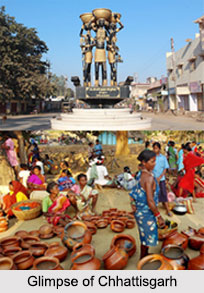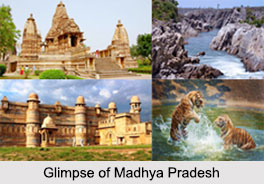 Central Indian States consists of Chhattisgarh and Madhya Pradesh. These states are the torch bearers of the central Indian culture and architecture. Madhya Pradesh has its origin from the Iron Age, while the history of Chattisgarh began with the hands of the formation of tribal culture from ancient era. In British India, these two states are known as the Central India Agency. The Central India Agency was made up entirely of Princely States of Bundelkhand region, which were under native rulers. The agency was bordered by the Central Provinces and Berar to the south; the Chota Nagpur princely states to the east, which were transferred from Bengal (now West Bengal in India and Bangladesh) to the Central Provinces and Berar in 1905; Agra and Awadh to the north; Rajputana to the northwest; and Bombay Presidency to the west and southwest.
Central Indian States consists of Chhattisgarh and Madhya Pradesh. These states are the torch bearers of the central Indian culture and architecture. Madhya Pradesh has its origin from the Iron Age, while the history of Chattisgarh began with the hands of the formation of tribal culture from ancient era. In British India, these two states are known as the Central India Agency. The Central India Agency was made up entirely of Princely States of Bundelkhand region, which were under native rulers. The agency was bordered by the Central Provinces and Berar to the south; the Chota Nagpur princely states to the east, which were transferred from Bengal (now West Bengal in India and Bangladesh) to the Central Provinces and Berar in 1905; Agra and Awadh to the north; Rajputana to the northwest; and Bombay Presidency to the west and southwest.
Chhattisgarh
Chhattisgarh which is also known as "Thirty-Six Forts" has many tourist attractions. This state has the domination of tribal settlements and the dense jungles of Chotanagpur Plateau. It is the 10th largest state in India, with an area of 135,194 square km. With a population of 28 million, Chhattisgarh is the 17th most-populated state of the nation. It is a source of electricity and steel for India, accounting for 15% of the total steel produced in the country. Chhattisgarh is one of the fastest-developing states in the country. Chhattisgarh is endowed with a rich cultural heritage and attractive natural diversity. The state is full of ancient historical monuments of Mahabharata era and the medieval era, rare wildlife and biosphere reserves, exquisitely carved temples of Ganga Dynasty and different tribal dynasties, Buddhist sites of ancient India, the palaces and the forts of Mughal and Delhi sultanate, waterfalls, caves of Iron and Stone Age settlements, rock paintings of early era and the plateaus of the hill stations. There are many waterfalls, hot springs, caves, temples, dams and National parks and wildlife sanctuaries in Chhattisgarh.
 Madhya Pradesh
Madhya Pradesh
Madhya Pradesh which is known as the "heart of India" due to its geographical location is the second-largest state in the country by area. Madhya Pradesh is the fifth-largest state in India by population. It borders the states of Uttar Pradesh to the north-east, Chhattisgarh to the south-east, Maharashtra to the south, Gujarat to the west and Rajasthan to the northwest. The ancient history of Madhya Pradesh says that the area which includes the present day Madhya Pradesh was of the ancient Avanti Kingdom before Mauryan era, whose capital was Ujjain. Ujjain was arisen as a major city during the second wave of Indian urbanization in the 6th century BC. Subsequently, the region was ruled by the major dynasties of India. By the early 18th century, the region was divided into several small kingdoms which were captured by the British East India Company and incorporated into Central Provinces and Berar and the Central India Agency. Then in independent India, Madhya Pradesh was formed with Bhopal as its capital.






